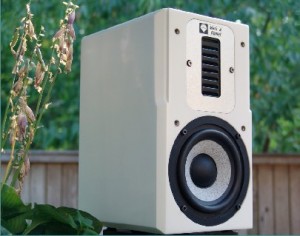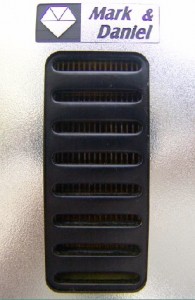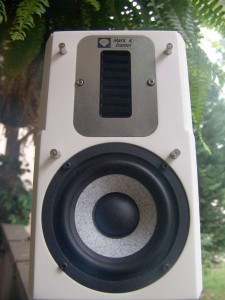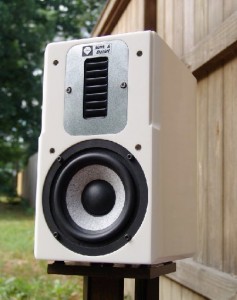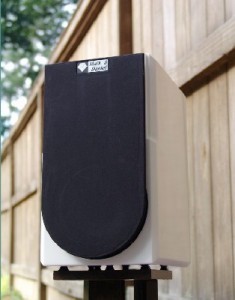Every month, new audio products are born and released into the competitive wilds of the high fidelity market. It’s been this way since well before I came into this world and, God willing, that’s how things will remain long after I’m gone. Passing glances into the cascading landscape of hi-fi transducers uncover a trove of offerings that range drastically in design, form and function. Yet when it comes to compact stand mount monitors, there’s a sense of sameness. After all, the audio cookbook already has a number of concrete recipes on how to make a great sounding, audiophile approved miniature loudspeaker. As with all things, it is only a matter of time until someone sets to break tradition by creating a custom recipe of their own.
In 2004, Mark Wong and Daniel Lee did just that by coming up with a design aimed to challenge the notions of what is possible from a compact monitor. It has long been established that without major tweaks, small speakers typically produce small dynamics and bass. Leaving cheap parlor tricks at the door, Mark and Daniel sought to transcend these bounds in a way no other company has done before. In 2006, waves of reviews began crashing onto hi-fi shores, singing songs of praise and admiration for these new compact speakers. Word of their performance spread quickly, eventually getting to yours truly. It is now my pleasure to share with you, my impressions of Mark and Daniels latest product to enter the line up, the Topaz.
Specifications:
- Frequency Response: 48Hz-25KHz Two-way Crossover: 900Hz
- Nominal Impedance: 4-6 Ohms
- Average Efficiency: 85.5 dB/2.83V/1m
- Power Handling: 㱢 60 Watts per channel
- Enclosure Material: C.A. Marble
- Size (H x W x D): 29.0 x17.0 x21.3 cm 11.4” x6.7” x8.4”
- Weight (each): 8.6 Kg (19 lb)
- Price$1800.00 / pair
Mark and Daniel Topaz review
Under the hood
The entry point for Mark and Daniel loudspeakers begins with the “Ruby”, a tiny speaker that caused big shockwaves over with the 6moons staff. For all at the Ruby has to offer, its thirst for lots of high quality current alienates itself as a viable option for many systems. After all, good clean current rarely comes with a low price tag. Recognizing the need for a more efficient speaker that could work well on medium powered solid state and tube electronics, Mark and Daniel developed the Topaz. In order to gain this efficiency, a small compromise had to be made in terms of ultimate bass extension and slam. Still, like the rest of Mark and Daniel’s kin – there is nothing standard or ordinary about these small monitors.
At the heart of the Topaz is the DM-4 Dreams wideband AMT (air motion tweeter) driver. As they say on MTV Cribs, this is where the magic happens. The unique and highly capable driver works by squeezing air out through its folded ribbon diaphragm. Just think of an accordion, and you’ve got the basic idea. The first advantage of the DM-4 is its low mass and large radiating surface area that generates a large and distortion free sound that far surpasses conventional dome tweeters. The second advantage is its huge bandwidth. While most conventional speakers use drivers that require a crossover point in the sensitive 2-3khz region, the DM-4 is capable of covering 5 octaves from 900hz all the way up to 25khz. This completely bypasses one of the biggest hangups most other compact monitors in the market suffer from.
The wide range of the DM-4 allows the completely custom 5.5” SX woofer to handle the lower octaves, the domain woofers were built for. The woofer used on the Topaz underwent a massive overhaul. First, in order to gain a 3db efficiency advantage over the Ruby, the motor structure had to be completely de-designed, along with the crossover network and voice coil. The magnet strength also had to be increased. While the linear excursion had to be drop to +/- 7.5mm, versus the usual +/-10mm found on all other Mark and Daniel SX woofers, the figure still exceeds that of most conventional woofers.
With a speaker capable of such strong output, regular MDF (medium density fiberboard) enclosures wouldn’t cut it. The material needed to be twice as dense. What Mark and Daniel ended up with is an enclosure cast from compound artificial marble, a material that is much stronger than MDF and even more durable than natural marble. The result is an extremely non-resonant box. During
the build process, each enclosure is hand assembled to meet rigid spec, assuring excellent quality control and consistent performance. Top that off with a set of high quality five way binding posts, and you’ve got something to instill some serious owner’s pride.
Set up and first impressions
A side benefit of compound marble is that it can be very aesthetically pleasing. Molded from what appears to be one slab of marble, the Topaz is free of veneer, seams, and visible screws. You could say that the Topaz prefers to live life au natural. Those of you that like to keep your speakers a bit more covered will find the grills to be a snap – literally. Threaded magnetized pegs secure the grill comfortably to the speaker without risking wear and tear. Overall, this package has great form and function.
Setting up the Topaz was not nearly the complicated task I was expecting it to be. I found that the duo responded best when placed roughly 2ft from the rear wall. Positioning them closer to the wall resulted in some bass boost, although not to any damning degree. Conversely, pulling the speakers out further into the room resulted in a lack of wholeness, or as I like to call it, oomf. Once you’ve got the positioning dialed in to satisfaction, the rest of the process is straight-forward.
First, the Topaz is one of those speakers that require toe in, meaning that the drivers need to be facing toward your listening position. Neglecting to do so may result in a scattered soundstage. Second, despite their gain in efficiency, you will still need an amplifier that is capable of good control.
Second, as mentioned above, you’ll want an amplifier with an iron grip. While I tried a variety of transistor amplifiers with moderate success, it took the 30wpc Red Wine Audio Signature 30 battery powered amplifier to really let the Topaz strut its stuff. Going off of a hunch, I pulled out the beguiling H2O Signature 150 (not yet on the market). This is one beastly amplifier. While most class D amplifiers weigh less than a toy poodle, the Signature 150 is an overbuilt 55lb tank that delivers 100 solid watts of ICE power. With nearly a KW of dynamic power on tap along with 400,000uf of capacitance, this amp pushed the Topaz with incredible ease. In all honesty, the Topaz does not need this kind of juice to sing. This is sheer overkill. Still, the sound complimented the Topaz so well that it quickly became my reference piece for the evaluation.
Let the music play
The first thing you should know about the Topaz is that it is not your garden variety laid back and reserve transducer. This is a speaker geared more towards listeners that want to experience the sensation of a musical performance through immediacy, dynamics, clarity, and transparency. Although I often find myself drawn to a more subtle and reserve type of sound, my time with the Topaz has me left me smitten with both sides of the fence. One thing’s certain, there is nothing that is shy or reserve about this speaker.
The next stand out virtue of the Topaz is its ability to extract every nuance of information from a recording. You won’t have to sit up and listen carefully for subtle details – they will jump right out at you. This level of transparency took some time to adjust to. At first, the Topaz struck my ears with such an abundance of high frequency that I was beginning to think it would make an excellent pin up example of a hyper detailed loudspeaker. Subtle parts of the music I’ve always associated as back round accompaniment suddenly asserted itself to the front of the performance. The chatter at the end of Pink Floyd’s “Have a Cigar” on “Wish you were Here” has always been an ideal track to test a systems ability to retrieve subtle detail. On the Topaz, the conversations, laughter, and sounds of cork popping was incredibly distinct and clear – suggesting that it was never meant to be subtle in the first place. I didn’t have to crank up the volume to hear it all. It was just there. That’s how it was with every piece of music I threw their way – from the squeak of the drum pedals from Led Zepplin’s “Since I’ve been Loving you” to individual audience coughs and claps on Diana Krall’s “Live in Paris” album. There are many recording studio monitor’s I’ve come across that would be completely humbled by this level of resolution. The most stand-out virtue of the Topaz is its ability to deliver a massive amount of acoustic energy. While a select number of compact loudspeakers are bestowed the ability to fill a room with wall-to-wall sound, none can project like the Topaz. Not to my knowledge at least. Typically, the further away you stand from a compact monitor, the more it begins to sound its size. This becomes especially apparent with dynamic music. The Topaz, within its range of operation, delivers energy that manages to give a palpable sense of live music even when you are outside of the listening space. This experience is akin to leaving or entering a room with live performers having a jam session. You don’t have to be in the room to feel the energy and the impact. Sure, larger speakers can pull of this trick – but an ultra compact monitor? That’s breaking new ground.
As with most speakers that are well endowed with a heightened sense of transparency, the sound of the Topaz rests largely on the quality of recordings and upstream components feeding it. Harsh and compressed music will not sound doctored in any way. Adversely, your ears will reap all the rewards that a well-engineered recording has to offer. Surprisingly enough, this exceptional resolution does not, I repeat, does not come at the expense of what we reviewers call musicality. The Topaz can be as musically rewarding as some of my more favorite traditional loudspeakers from Totem Acoustic and Spendor classic. While it does prefer to dine on high grade steak, it’ll also do just fine with a hamburger and fries. As usual with any high quality speaker – the better you treat it, the better it’ll treat you.
Instead of placing instruments and vocals carefully behind the landscape, the Topaz gives you a “front row” experience, sporting a forward soundstage that calls you to attention. Sitting roughly six feet back, the Topaz shot out notes with great velocity and air. This brought back memories I had of the Martin Logan Prodigy. Every instrument and voice mixed in the recording comes across as full, distinct, and individual. The height and width of the soundstage never soars ceiling high, nor does it ever embellish the sound of certain instruments and vocals, as is often the case with the Martin Logan Prodigy. The soundstage is more confined within the confines of the speaker’s physical location. If anything, the one thing missing from the presentation was a more focused image.
Anchoring the whole presentation is very powerful and rich sounding bass that takes on a slightly thick/warm character. This tone, or saving grace as I’d like to call it, helps build a personality that keeps the Topaz from falling into the category of high-resolution loudspeakers that leave you impressed, yet otherwise emotionally cold. While transient details within its range do not leap off the driver with instant decay, it is by no means disjointed or slow. The Topaz had no problems keeping up with complex bass guitar riffs and rapid synthesized beats. The fact that it can seamlessly match the ultra quick DM-4 driver and maintain exceptional coherence speaks for itself.
Yet, it’s not the articulation or extension of bass that makes the Topaz stand-out among the crowd. The special to-do resides in the ability to deliver tremendous proportions of clean and distortion free output even with dynamic music. The Achilles heel of nearly every single compact monitor is maintaining strong and clean bass during moments of high output. When you play music that demands low frequency gusto, most monitors end up sounding, well – small. Even the most rugged of tiny speakers throw in the towel when it comes to reproducing the cannons from Telarc’s 1812 overture. The Topaz is able to pass this test with flying colors. In fact, from 60hz on up, the Topaz is the very first compact monitor I’ve encountered that can convincingly give the illusion of a larger transducer at work. Those of you limited on space should be
very excited.
A few nit picks
Although this is not a complaint per say, my impressions of the Topaz came in evolutions that initially started off as disappointment. As time went on that disappointment turned into mild appreciation, to enjoyment, to finally, being surprised and content. I can’t help but wonder if these 4 steps to acceptance are part of the speakers break-in process, or if it is merely the reaction of a sequential adjustment period to an unfamiliar presentation. Whatever the answer, I advise following standard protocol by putting a good 100 hours on the speakers until passing final judgment.
The Topaz can be an aggressive speaker. During my 4 step process, there were times when I felt that my ears were being assaulted with an over abundance of high frequency information. Some call it high frequency overload. To add insult to injury, the DM-4 driver also has a natural tendency to beam at moderate to higher volumes. While most of these symptoms have inexplicably subsided, there still lingers a very audible emphasis in the midrange and high end. While I’d imagine a good tube component could act to counter this aggression – I feel that this is simply part of who the Topaz is.
I also felt that the soundstage could benefit from greater precision and focus. While the Topaz can project well into a room with exceptional air and distinct separation around each note, it never seemed to jell together to paint a well-defined soundstage. It’s like trying to assemble a puzzle when none of the pieces fit. While this may be a function of my own room and electronics, I encountered the same results in other audiophile abodes. As an interesting aside; I found the Topaz to work exceptionally well in ultra near field circumstances where precise imaging is not a necessity.
Some of you may have noticed my making mention of the impressive bass response at and above 60hz, even though the Topaz is spec’d with an F3 of 48hz. I noticed that below 60hz, the output began to drop significantly –even with room gain on its side. While the Topaz can hit a 48hz note with no problem, I found that the claimed F3 to be slightly generous. Overall, this is an omissible sin. Remember, some bass performance had to be sacrificed in order to gain greater efficiency.
That said, I belong to the camp that feels bass is a living and breathing force that drives music. Without it, you’re missing half the message. Impressive as the Topaz may be, full range, it ain’t. To ease my bass woes, I relied on wonderful Totem Acoustic Storm, a subwoofer which stole my heart, (as seen in the August issue) to match the speed and character of the Topaz. It worked splendidly, leaving all the virtues of the Topaz in tact all the while filling in exactly where they left off.
Final thoughts about Mark and Daniel Topaz
Small on size and big on sound – the Topaz sets many new standards in the world of compact twoway loudspeakers. Unlike the Ruby, a speaker that requires premium grade power transistors to sing well – the Topaz can deliver nearly identical performance on more down to earth components. Some may call these accomplishments in performance, revolutionary, I’ll take a different tact and simply call it phenomenal.
Imagine large scale and high quality sound from a speaker that’s smaller than a lunchbox. No, Suzy, it is not the stuff of dreams anymore. Far from it, this is in fact very real. Even if your personal preference leans more to the gentle side of things, these speakers may just surprise you. The Topaz earns my highest recommendation as a “must hear” component.
It bears mentioning that the above review reflects on he latest incarnation of the Topaz, which received a much needed crossover upgrade in August of 2007. This change came not long after reviewer feedback (my own included) reported results that were less than stellar. Prior to the new crossover, I found the sound to be mediocre at best. Now the performance is top notch. I tip my hat in respect to Mark and Daniel for lending themselves open to opinion and suggestion. This is a company that is truly concerned with delivering great sound and value.
Review Equipment:
- Arcam Diva 62 ;
- E-MU 1212M H2O Fire H2O Signature 150 Red Wine Audio Signature 30 ;
- Harman Kardon 3475 Totem Acoustic Sinew interconnect ;
- Totem Acoustic “Tres” speaker cable;
- Zu Cable “birth” power cable ; Audio Limits Shield 3.1 power cable Eighth Nerve “Adapt” Triangles ;
- GIK Acoustics 242 Panels
external link: Topaz on Mark and Daniel official website
 from affordableaudio, By Zero
from affordableaudio, By Zero

